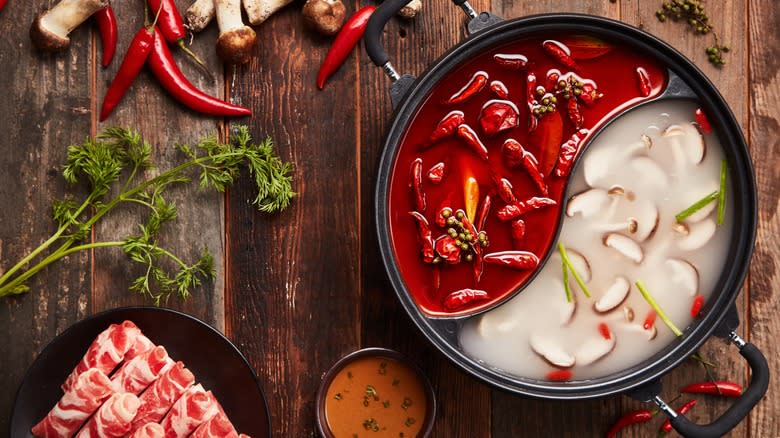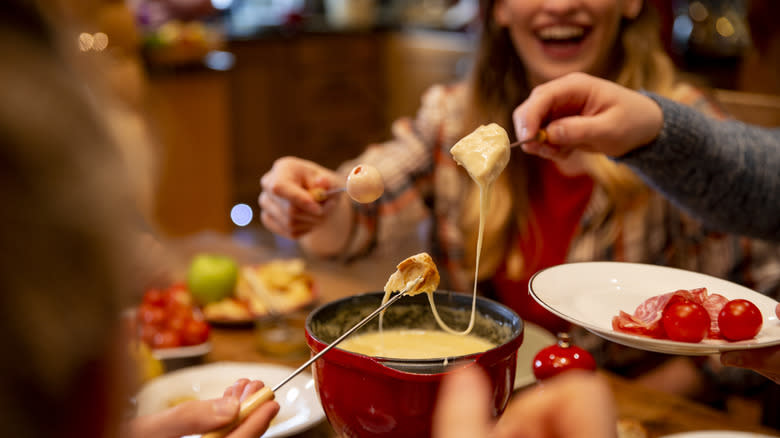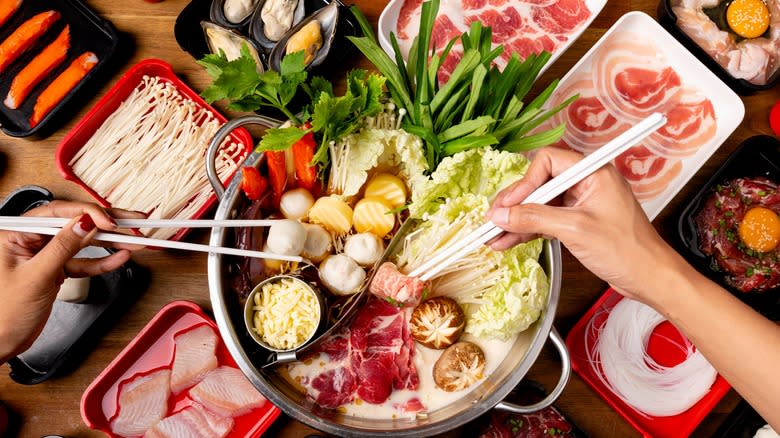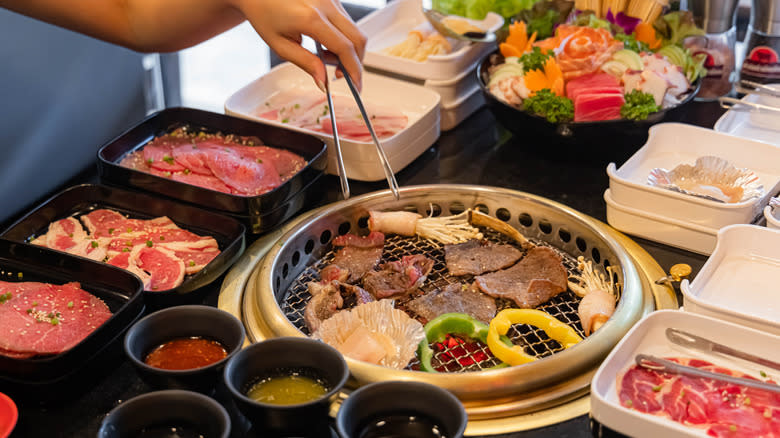Here's How 'Cook-It-Yourself' Restaurants Typically Work

For most people, dining out holds endless intrigue, with opportunities for exploring interesting foods, international cuisines, and new twists on old favorites. The lure of restaurant dining obviously includes the glorious fact that someone else is doing the shopping, planning, cooking, and cleaning, at least for that suspended moment in time. Given those undeniable pleasures of eating out, it seems absurd that anyone would pay good money to cook their own food in a dining establishment. However, a whole lot of people do just that -- and the concept is not so far-fetched as you'd imagine.
Also known as interactive dining, the trend of cook-it-yourself restaurants is slowly morphing into a favored experience, eclipsing the usual "seat and eat" routine. It taps into a deeply ingrained desire for communal eating, one born and enforced through memories of outdoor picnics, neighborhood barbecues, family-night church suppers, and other hands-on shared meals. While standard restaurant dining is largely a passive activity, cook-it-yourself venues give everyone an active role in the meal -- without the stress of being in charge.
Sharing a meal with family, friends, or coworkers can be stressful, depending on the relationship or situation. But cook-it-yourself eateries help break the ice, keep the conversation flowing, and encourage shared good will. That's made possible by carefully planned routines set up by the restaurant and staff, who guide the experience with platters of pre-planned raw ingredients and table-side cooking methods. Here's a look at some popular trends in the you-cook dining scene.
Read more: Styles Of Regional BBQ In The US
Fondue, A Longtime Favorite

Cook-it-yourself restaurants are having their day in the sun, but the concept itself isn't exactly new. Think of that fondue pot stuffed in the back cupboard of your kitchen, or more likely in your parent's or grandparent's pantry. This type of table-side cooking entered the American dining scene in the 1960s, eventually becoming a home-party phenomenon before dissipating somewhat in the following decades. However, it's recently entered retro-nouveau territory, re-kindling longtime fondue chains such as the Melting Pot.
Fondue originates in Switzerland but the name is actually French, from the word "fondre," which translate as "melt." It's essentially a form of hot pot cooking, but with at least one important difference. While hot pot restaurants employ broth to cook the food, fondue focuses more specifically on melted artisan cheeses such as Gruyère and Raclette, as well as melted chocolates, served in multiple courses. The server brings out warm pots of melted cheese, often infused with wine and spices, accompanied by long forks and an array of dipping options, such as crusty cubed breads, apple slices, salami, crunchy veggies, meatballs, and roasted potatoes.
Everyone in your dining party joins in the fun, with the warm cheesy and chocolaty pots perched in the middle of the table. Once all the deliciousness arrives, it's pretty much a you-cook situation, with the server replenishing goods as needed and introducing new courses, depending on what you've ordered.
Chinese Hot Pot And Japanese Shabu Shabu

Genuine hot pot cooking comes in many international iterations, particularly ones from the Asian continent. The most common hot pot traditions making their way to Western-style restaurants are versions from China and Japan. Both involve broth or hot water for cooking, but the technique differs considerably.
Chinese hot pot meals date back centuries and possibly entered the Chinese culinary scene by way of neighboring Mongolia. With hot pot dining, the server places steaming pots of broth on burners located on the table. There are often split or divided pots for holding both mild, aromatic broth and a spicy version. Scattered around the table are serving bowls brimming with thinly sliced raw meats, seafood, dumplings, vegetables, rice cakes, corn cobs, mushrooms, and much more. The guests take over the cooking, dropping chosen ingredients into pots as desired, and pulling them out at preferred levels of doneness. Sauces await for dipping the hot cooked morsels.
Then there's the Japanese version of hot pot, playfully named shabu shabu, meaning "swish swish." It refers to the actual cooking process in which diners swish morsels back and forth in boiling kelp-based broth until cooked. You're cooking only one piece of food at a time, which requires extra thin slicing of meats and vegetables for quicker cooking. Common proteins for Japanese shabu shabu are Wagyu beef and kurobuta Berkshire pork, but some restaurants offer salmon, lamb, and poultry as well.
Korean Barbecue And Japanese Yakiniku

Hot pot isn't the only you-cook fun in town, with at least two different varieties encouraging customers to cook their own food at the table. These switch from brothy cooking to barbecue style, one from Korea and the other from Japan.
Korean barbecue in the U.S. has become more mainstream, especially in cities with strong Korean communities. Like hot pots, it's hands-on and communal, but the meats and vegetables get sizzled on small grills built into the tables. This allows easy access for each person to customize and cook their own food. Beef short ribs are a favorite for Korean barbecue as are brisket, sirloin, spicy pork, and pork belly. Meats typically come marinated in sauces such as chili paste, sesame oil, or soy sauce, and vegetables are often fermented in kimchi style. A wide array of dipping sauces await, and final results can be eaten alone or tucked in lettuce or rice wraps.
The Japanese iteration of table grilling is known as yakiniku, a word translating as "grilled meats." It was reportedly influenced by Korean immigrants in the 1920s but has since evolved into its own style. Though many yakiniku devotees prefer cooking with thinly sliced meats, it's common to be offered medium or thick cuts, along with guides for cooking times. In upscale yakiniku eateries, patrons select several different bite-sized cuts and styles of meats, allowing individual sampling. Some even feature "tabehodai" courses, meaning all you can eat in a set time period.
Read the original article on Tasting Table

